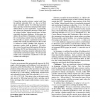Free Online Productivity Tools
i2Speak
i2Symbol
i2OCR
iTex2Img
iWeb2Print
iWeb2Shot
i2Type
iPdf2Split
iPdf2Merge
i2Bopomofo
i2Arabic
i2Style
i2Image
i2PDF
iLatex2Rtf
Sci2ools
WWW
2001
ACM
2001
ACM
Crawling the Hidden Web
Current-day crawlers retrieve content only from the publicly indexable Web, i.e., the set of Web pages reachable purely by following hypertext links, ignoring search forms and pages that require authorization or prior registration. In particular, they ignore the tremendous amount of high quality content "hidden" behind search forms, in large searchable electronic databases. In this paper, we address the problem of designing a crawler capable of extracting content from this hidden Web. We introduce a generic operational model of a hidden Web crawler and describe how this model is realized in HiWE (Hidden Web Exposer), a prototype crawler built at Stanford. We introduce a new Layout-based Information Extraction Technique (LITE) and demonstrate its use in automatically extracting semantic information from search forms and response pages. We also present results from experiments conducted to test and validate our techniques.
Related Content
| Added | 22 Nov 2009 |
| Updated | 22 Nov 2009 |
| Type | Conference |
| Year | 2001 |
| Where | WWW |
| Authors | Sriram Raghavan, Hector Garcia-Molina |
Comments (0)

